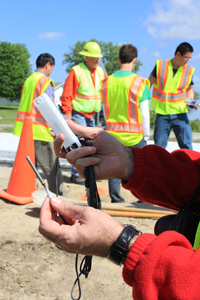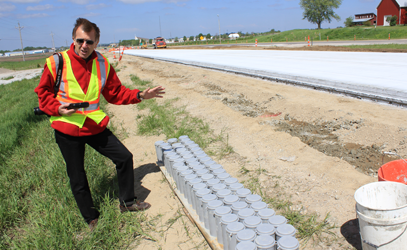 On May 24, 2013, a group of four graduate students, four undergrad research lab students, and others led by civil engineering Associate Professor Halil Ceylan, went out to a freshly paved section of Highway 30 a few miles east of Interstate 35. The team was there to measure concrete pavement responses under in-situ, or on-site, conditions using wired and wireless sensors set in place by the team one day before paving. The Iowa Highway Research Board (IHRB), who funds this study, aids Ceylan in the first study of its kind in Iowa.
On May 24, 2013, a group of four graduate students, four undergrad research lab students, and others led by civil engineering Associate Professor Halil Ceylan, went out to a freshly paved section of Highway 30 a few miles east of Interstate 35. The team was there to measure concrete pavement responses under in-situ, or on-site, conditions using wired and wireless sensors set in place by the team one day before paving. The Iowa Highway Research Board (IHRB), who funds this study, aids Ceylan in the first study of its kind in Iowa.
Ceylan’s team tests to make sure that the concrete performs as it should under various conditions, such as temperature and relative humidity gradients. They also look at the stresses and strains in the concrete pavement itself. Ceylan aided the students in placing displacement probes within the newly formed concrete in order to monitor the displacement (curling and warping) behavior of the pavement systems. The Iowa Department of Transportation (Iowa DOT) wants to use this data to assess health of roadways faster and more efficiently. With the data gathered from this research study, there will be progress to achieve long lasting roadways as we better understand and document their in-situ behavior under traffic and environmental loads.
Sensors embedded into the concrete slabs at the Highway 30 site capture the temperature, moisture, and strain data, which is recorded off site into a data logger. Most of the sensors that the team uses in this site instrumentation currently are state-of-the-art Commercial Off-the-Shelf (COTS). However, Ceylan’s team is developing its own wired and wireless Micro-Electro-Mechanical Sensors and Systems (MEMS) devices in Iowa State labs for continuous health monitoring and management of concrete pavement systems.
With about 4 million miles of roadways in the U.S., Ceylan’s research could have vital impact on how we travel. “This research could one day influence the conditions of the roads we drive on, making them last longer, smoother, and also safer,” Ceylan said.
CCEE communications intern Alex Hagar contributed to this story.
